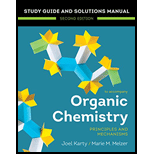
(a)
Interpretation:
Energy diagram for the given
Concept introduction:
The nucleophilic substitution reaction that takes place in two steps, through the formation of a carbocation intermediate, is called the unimolecular nucleophilic substitution
(b)
Interpretation:
Energy diagram, for the given
Concept introduction:
The nucleophilic substitution reaction that takes place in two steps through the formation of a carbocation intermediate is called unimolecular nucleophilic substitution
Want to see the full answer?
Check out a sample textbook solution
Chapter 8 Solutions
EBK ORGANIC CHEMISTRY: PRINCIPLES AND M
- Explain how you can tell from the energy diagram that the reaction with the catalyst in Fig. 8.4 isfaster than the reaction without the catalyst.arrow_forwardww. meinerbeMorW 29.Draw a detailed free energy diagram for the following E1 reaction. Include and label the overall reactants, the overall products, the intermediate(s), the axis, and the transition state(s). HOC(CH3);arrow_forwarddo 8.52!arrow_forward
- 1. Draw the mechanism for the following reaction. Include all intermediates, formal charges, and arrows. ol CH3CH₂NH2 H*, -H₂Oarrow_forward10. Draw the complete, detailed mechanism (curved arrows) for the following reaction, and predict the major product. CH3 ▪OH 1. DMSO (COCI)2 2. Et3N Harrow_forwardPls helparrow_forward
- 1. Please list the conditions for the following conversions and draw the stepwise mechanism for both reactions. Br mechanism A mechanism B Mechanism A: Mechanism B:arrow_forward2. Draw the carbocation rearrangements for each of the following carbocations. yearrow_forwardCan i see the mechanism for this reactionarrow_forward
- 6. Explain why halogenation occurs twice in the following reaction. Ch₂ NaOH give both answer asap thanks 7. Draw a complete, detailed mechanism for the following reaction. Label the electron-rich and electron-poor sites in each step. H₂SO₂ OSOHarrow_forwardConsidering stereochemistry, draw the resulting E2 elimination product when H. is removed. H a Ho III.... H H₂ I jº ·*||||| H X Ś my èarrow_forward1. Draw the mechanism for the following reaction. You should show the initiation and both propogation steps, you do not have to show termination steps Br₂ heat or light Br Draw a reaction coordinate diagram for the reaction in 1. Hint: How many steps are there? In what step is the organic plecule most reactive and least stable?arrow_forward
 Organic Chemistry: A Guided InquiryChemistryISBN:9780618974122Author:Andrei StraumanisPublisher:Cengage Learning
Organic Chemistry: A Guided InquiryChemistryISBN:9780618974122Author:Andrei StraumanisPublisher:Cengage Learning
